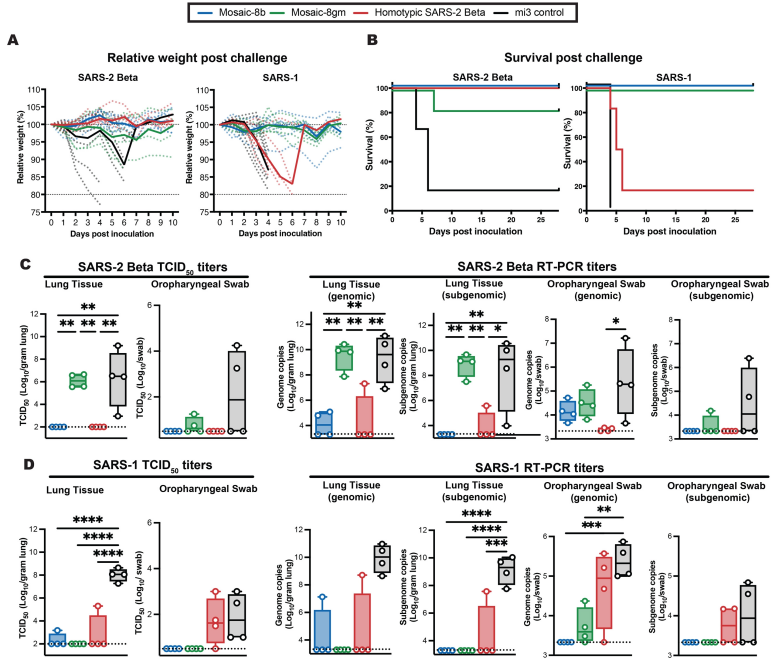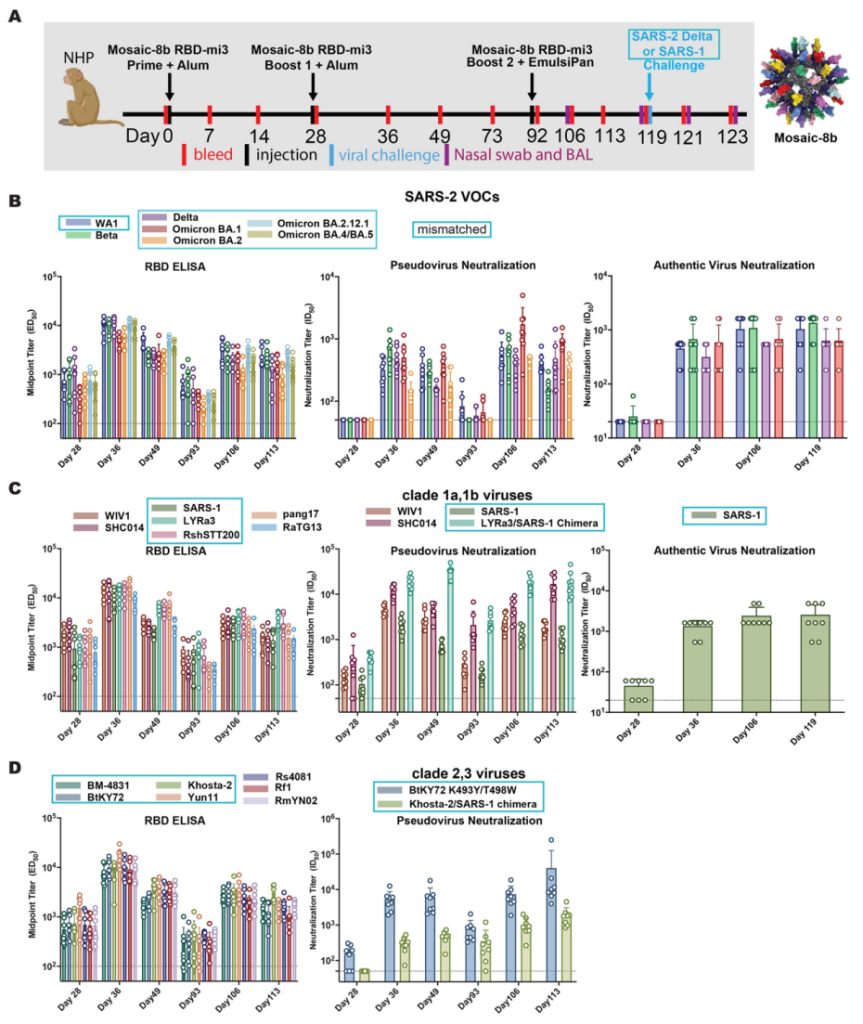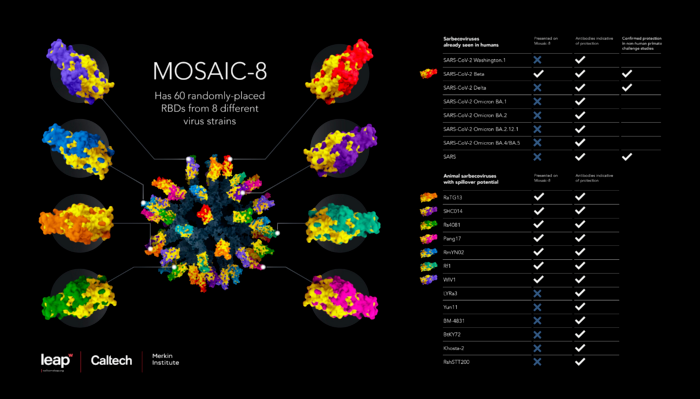Coronaviruses are a large group of viruses that exist widely in nature, and they are also the viruses with the largest genome among the known RNA viruses. The 2019 novel coronavirus (2019-nCoV/SARS-CoV-2) is the seventh known coronavirus that can infect humans, and the other six are HCoV-229E, HCoV-OC43, HCoV-NL63, HCoV-HKU1 , SARS-CoV (Severe Acute Respiratory Syndrome Coronavirus) and MERS-CoV (Middle East Respiratory Syndrome Coronavirus). Betacoronaviruses are meant to include those viruses that cause SARS, MERS, and SARS-CoV-2, and are a subset of coronaviruses that infect humans and animals.
On July 5, 2022, the California Institute of Technology in the United States and the University of Oxford in the United Kingdom jointly published a research paper entitled “Mosaic RBD nanoparticles protect against challenge by diverse sarbecoviruses in animal models” in the top journal Science in the form of “first release”. The research team said it is developing a multifunctional vaccine called “Mosaic-8” that can protect people from future variants of the new coronavirus, new strains of coronaviruses such as SARS and MERS.
Mosaic-8: a vaccine composed of the spike domains of 8 different SARS-like coronaviruses
It is reported that the “Mosaic-8” vaccine uses 60 fragments of 8 coronavirus strains, including the new coronavirus. The researchers attached fragments of the spike structures of eight coronaviruses to vaccines composed of protein nanoparticles. The nanoparticle is attached with tagged viral proteins. When the vaccine is injected into an animal, the nanoparticle vaccine presents these viral fragments to the immune system, which stimulates the immune system to recognize and produce proteins that fight specific pathogens, thereby activating T. The immune response of lymphocytes and innate immune cells. The data showed that mice vaccinated with the mosaic nanoparticles were not only protected from eight viruses, but also from the SARS and SARS-CoV outbreaks in 2002 and 2004.
To further observe the effectiveness of “Mosaic-8”, the team conducted three sets of experiments on mice. The first group was a control group, and they only inoculated the mice with nanoparticle cage structures without any viral fragments attached; the second group of mice were injected with a homotype nanoparticle covering only the SARS-CoV-2 RBD (Receptor bind domain). particles; the third group was injected with a nanoparticle called “Mosaic-8.” The mice used in the experiments were genetically modified to express human ACE2 receptors (Note: ACE2 receptors are the relevant receptors for 2019-nCoV and related viruses when infecting human cells).
The researchers found the following:
Mice inoculated with naked nanoparticle structures died when infected with SARS-CoV or SARS-CoV-2;
Mice vaccinated with isotype nanoparticles encapsulated only with the SARS-CoV-2 RBD were protected against SARS-CoV-2 infection but died of infection when exposed to SARS-CoV. This result indirectly suggests that the same type of SARS-CoV-2 nanoparticle vaccine currently under development in multiple countries may be effective against SARS-CoV-2, but may not broadly protect against other SARS-like betacoronaviruses from animal hosts or future SARS-CoV-2. CoV-2 variants;
Mice vaccinated with “Mosaic-8” nanoparticles survived the challenge of exposure to both SARS-CoV-2 and SARS-CoV without weight loss or other significant pathological changes.

The researchers confirmed that the vaccine induces “broad-spectrum” antibodies to target the coronavirus’ “spike protein” in mice genetically engineered with human-like cell receptors. So what about the effects on primates? Let’s continue to find out.
Equally effective against non-human primates, protects against future variants
Subsequently, in order to verify and observe the effect of the vaccine in primates, the research team further conducted similar experiments in non-human primates to directly compare the effects of vaccinated “Mosaic-8” vaccine and unvaccinated. The researchers found that when vaccinated with “Mosaic-8,” no viral infection was detected in animals exposed to SARS-CoV-2 or SARS-CoV. The results again suggest that the “Mosaic-8” vaccine candidate has the potential to protect against current and future virus variants responsible for the COVID-19 pandemic, or to prevent future SARS-like betacoronaviruses from potential viruses in animal hosts overflow.

Next, the study leader, Professor Pamela J. Bjorkman, will lead the team to evaluate the safety and efficacy of the nanovaccine in a Phase 1 clinical trial supported by the Coalition for Epidemic Preparedness Innovations (CEPI). . Clinical trials will primarily enroll people who have been vaccinated and/or previously infected with SARS-CoV-2. Meanwhile, in preparation for clinical trials in advance, the Bjorkman lab is planning to conduct preclinical animal model experiments to compare the immune response of animals previously vaccinated against COVID-19 with those of animals insensitive to SARS-CoV-2 infection or vaccination .
Richard J. Hatchett, PhD, CEO of CEPI, said: “Since the beginning of the pandemic, we have discussed the need to diversify vaccine development, and this new research breakthrough demonstrates the enormous potential of finding new vaccine platforms to overcome future The mutated strain of COVID-19 offers hope. I am pleased to announce that CEPI will provide full support to assist in the Phase 1 clinical trials of this vaccine.”
The new coronavirus mutates constantly, a “pan” coronavirus vaccine is imperative
Over the past three years, new variants of the new coronavirus have emerged, giving us a deep understanding of the “changeable” nature of the coronavirus. No one can predict when a new coronavirus will cause a pandemic in human society, but developing a vaccine that can deal with various coronaviruses in the future may protect us better.
Professor Bjorkman said, “It turns out that SARS-CoV-2 has demonstrated its ability to create new strain variants that prolong the duration of the global COVID-19 pandemic. In addition, over the past 20 years, three betacoronaviruses have been Successfully infect humans from animal hosts. Because we cannot predict which of the many viruses hidden in animals will successfully evolve and infect humans again. And each infection may lead to another pandemic sweeping the world “What we’re trying to do is to develop an all-in-one vaccine that protects against SARS-like betacoronaviruses no matter which animal-borne virus or how far the virus has evolved. Not only does this vaccine protect against SARS-CoV-2 of current variants, and even predicting future variants, without the need to update them once and for all. These facts point to the high stakes and urgency of producing a vaccine with broad protection.









